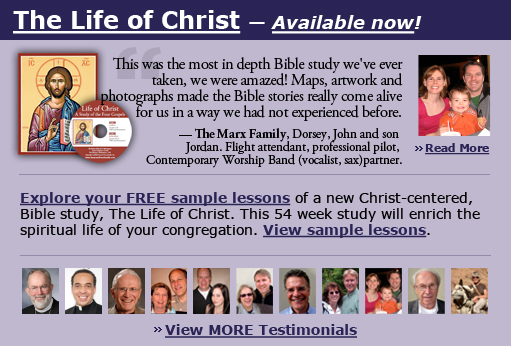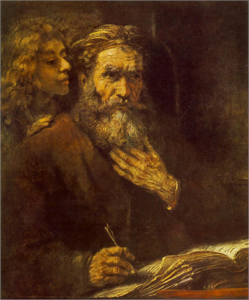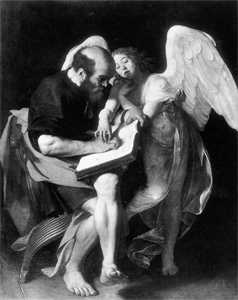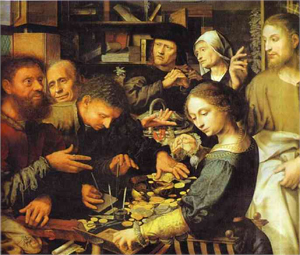
Christmas
Easter
Pentcoest
All Saints
Christ The King
Confirmation
Palm/Passion
Reformation
Stewardship
Books of the Bible
Lenten Series
Christmas Dramas
Videos
Series A - Matthew
Series B - Mark
Series C - Luke
Series D - Other
To contact
Edward F. Markquart
info@sfs.com

Series B EPIPHANY 8A Matthew 2:13-22 Pastor Edward F. Markquart The following Bible study is from a larger course entitled THE LIFE OF CHRIST: A Study in the Four Gospels. This 54 week course for the laity will be available for congregations in 2006. Basic text for the course: SYNOPSIS OF THE FOUR GOSPELS, Kurt Aland, English Edition, P. 42-43. #44 THE CALL OF LEVI (MATTHEW) Matthew 9:9-13; Mark 2:13-17; Luke 5:27-32 Like all stories, this is another good story in which to look carefully at the details that help us appreciate the fullness of the narrative. -Jesus went out again beside the sea; the whole crowd gathered around him, and he taught them. The sea in the text is the Sea/Lake Galilee.
http://www.christiananswers.net/bibleplaces/home.html
-As he was walking along, he saw Levi son of Alphaeus sitting at the tax booth, Levi was a tax collector. Tax collectors were hated and despised in Jesus’ day. These Jewish tax collectors were working for the Romans by collecting Roman taxes. The tax collectors made a healthy commission by tax collecting and they were the richest people in town. There were several Roman taxes: a ground tax on which a Jewish farmer paid 10% of his grain and 20% of his fruit to the Romans; an income tax of 1%; a poll tax just for living; a travel tax to travel on Roman roads; an animal tax to take your animal on the Roman roads, etc. One Biblical commentator says that “tax collectors were universally hated and notoriously dishonest.” The tax collectors were disbarred from attending the synagogue and they were considered unclean by the Jewish law. The Jews of that era looked down on tax collectors. We recall in Luke 18:11 that “The Pharisee stood up and prayed about himself: 'God, I thank you that I am not like other men-robbers, evildoers, adulterers-or even like this tax collector.” In other words, tax collectors were in the same category as robbers and adulterers. We also think of Matthew 18:17 which says, “And if he refuses to listen even to the church, treat him as you would a pagan or a tax collector.” In other words, "kick the guy out. Don’t have anything to do with him. Ostracize him. He is like a tax collector, so get rid of him." Also, some Biblical scholars conclude that Matthew was the collector of the literary materials that were added together to compose the Book of Matthew. Matthew himself may have been the author of Special M, those special verses that are found only in Matthew. Matthew would have relied heavily on the outline and content of the Gospel of Mark (coping 91% of Mark), plus the teaching document called Q, and the Special M material. As a tax collector, he would know how to write, unlike the fishermen who were Jesus’ disciples. An Early Church Father by the name of Irenaeus (200 CE) concluded that Matthew, the tax collector, was the “author” of the “Hebrew book,” the Jewish Gospel of Mathew. The following painting is by Rembrandt. Notice the book in the painting. The book is symbolic of Matthew being the final collector (author) of the Hebrew gospel which was written especially for Jewish people. Notice the “angel” behind Matthew. The “angel” is symbolic of the angel giving Matthew the message of the gospel. As a person looks at the painting, it is easy to imagine that Matthew is listening carefully to the angel behind him. It seems that the angel is whispering into the ear of Matthew. Notice that the angel is simply a messenger and has no wings as does the following portrait of an angel by Caravaggio. http://www.wga.hu/frames-e.html?/art/r/rembran/painting/biblic2/matthew.jpg
The following painting is by Caravaggio. Notice that book which is symbolic of Matthew being the author (final collector) of the Gospel of Matthew. Notice the angel or messenger. Notice the angel’s fingers delicately on the hand of Matthew. It is as if the angel is guiding Matthew as he writes his gospel. http://www.wga.hu/frames-e.html?/html/c/caravagg/04/25conta.html
-And he said to him, "Follow me." And he got up and followed him. We assume that Matthew previously knew Jesus and heard and seen him talk on other occasions. The invitation to discipleship was follow Christ and Matthew did. We, too, are to follow Christ, to walk in his footsteps, to follow his path of love. Circle he words, “follow me.” That is what disciples do: we follow Jesus. See the painting below. Jan Sanders van Hemessen. Jesus Summons Matthew to Leave the Tax Office. 1536. Oil on panel. Alte Pinakothek, Munich, Germany. We can see that the painter envisioned Jesus and Matthew in sixteenth century German customs. http://www.abcgallery.com/H/hemessen/hemessen4.html
-He left everything. Only in Luke. Highlight. Notice that Luke again emphasizes that Matthew “left everything” and followed Jesus. Similarly, in Luke 5:1-11, p. 22 in the SYNOPSIS, we notice that the first disciples “left everything” and followed Christ. In Luke’s version of the story of the rich young ruler, Luke 18:22, p. 218, notice that only Luke has the rich young ruler selling all that he has. When we finally get to Luke’s book of Acts and the lives of the early Christians, we will find these early Christians selling their possessions and giving the gifts to the poor. Luke seems to be building his description of radical discipleship in which a Christian shares generously of his/her material possessions with the poor...and leaves everything behind. Some Christians and churches have interpreted these sections of the Bible literally e.g. “Sell all you have and give to the poor.” The result is “medieval monasticism” where monks sell all their property in order to be monks/priests who pledge “poverty, chastity, and obedience.” Throughout history, certain Christians have interpreted these passages to mean to God wants us to live a life of poverty. I am not one of them. -And as he sat at dinner in Levi's house,The gospels tell us that the scene has changed in this story, and it is now at the home of Matthew and that Matthew has prepared a great feast. It seems that this conversation was held in the house belonging to Levi, the tax collector. -Many tax collectors and sinners were also sitting with Jesus and his disciples—for there were many who followed him.So it wasn’t just Matthew who was present. There were a whole group of tax collectors present with other sinners. How did the other tax collectors get there? They were invited. By whom? By Matthew, we assume. Matthew had gone out to other tax collectors and told them about Christ and invited them to his own home for a meal with Jesus to see for themselves who this Jesus was. It reminds us of the story of the “Samaritan woman at the well” and her invitation for her friends to come and see this Jesus. In other words, this is another "evangelist" story. -When the scribes of the Pharisees saw that he was eating with sinners and tax collectors, Again, in so many of the stories about Jesus, there is a conflict set up between the legalistic righteousness of the Pharisees/scribes and the “so-called” unrighteousness of the tax collectors/sinners. This is the first of innumerable conflicts between Jesus and the Pharisees. -They said to his disciples, "Why does he eat with tax collectors and sinners?"This is at the heart of the story. We recall the previous comments about tax collectors who were hated and despised in Jesus’ day. Jesus seems to consistently be drawn to the people of the land, the downtrodden, the poor, the maimed, the blind, the lame, the outcasts, the lepers, the demonics, the epileptics, and the paralytics. None of these people were part of the religious establishment of Jesus' day nor were they found in the synagogue on Friday night because they were excluded from the synagogue for various religious reasons. Such people were considered “sinners.” When Jesus heard this, he said to them, "Those who are well have no need of a physician, but those who are sick; I have come to call not the righteous but sinners."This teaching, too, is at the heart of the story. This is why this particular story is included in this place. The story is ostensibly about Matthew’s call to discipleship, but the reason this story is placed in this location among the other healing stories is that sick people need a doctor. Jesus became known as the Great Physician because Jesus healed both sick bodies and sick souls/emotions/minds. Jesus came to heal those who were sick physically and sick emotionally/spiritually/mentally. Some people do not think that they need the healing of Christ; others do. Jesus wants us to see ourselves as people who need the healing powers of Jesus in our lives. -Go and learn what this means. I desire mercy and not sacrifice. (only Matthew) Matthew’s gospel, appealing to a Jewish audience, once again quotes from the Old Testament, from Hosea 6:6. The Pharisees and their scribes had defined their religion by doing the sacrifices, obeying the Jewish laws and traditions, and following letter of the law of their Bible, especially the Law/Torah. (The Law is composed of five books of the Bible: Genesis, Exodus, Leviticus, Numbers and Deuteronomy.) We Christians can become like the Pharisees of old and obey our Christian traditions, Christian laws and Christian interpretations that become more important than being merciful like God/Jesus. The word, “sacrifice,” is symbolic of religious rituals, religious traditions, religious interpretations which become more important than everyday, common mercy that people can give to one another. A fundamental problem for the Old Testament prophets was that people “did religion” as a substitute for doing justice and righteousness for the needy. The same problem exists today when people “do the church thing” as a substitute for doing mercy in our world around us. -I came not to call/invite the righteous but sinners. Highlight. The word, “call,” can also be translated “invite.” Jesus did not invite people who thought they were righteous but people who knew their need of God. Similarly, with us as Christians, we are to extend our invitation to know and follow Christ to those who know their need of Christ/God in their lives. This is the first New Testament passage quoted by the early church fathers as Scripture. -To repentance. (Only Luke) Luke likes the word, “repentance,” and inserts in here. We are to turn from our sins. #45 THE QUESTION ABOUT FASTING Matthew 9:14-17, Mark 2:18-22, Luke 5:33-39 All three synoptic Gospels are again parallel. This passage is included here because this story connects with the next story about a man being healed on the Sabbath. The Pharisees were very legalistic in their interpretation of the Torah that Jesus and others were not to heal on the Sabbath. -Now John's disciples and the Pharisees were fasting; and people came and said to him, "Why do John's disciples and the disciples of the Pharisees fast, but your disciples do not fast?" Circle the word, “fasting.” Fasting meant to abstain from sex, bathing, and eating certain foods as a symbol of penitence towards God. -Jesus said to them, "The wedding guests cannot fast while the bridegroom is with them, can they? Jesus again traps the Pharisees in their own metaphors and logic. Jesus is again brilliant as he forces the Pharisees into thought patterns and mental traps that they do not like. As long as they have the bridegroom with them, they cannot fast. The days will come when the bridegroom is taken away from them, and then they will fast on that day. Jesus was and is the bridegroom. He brought with him the joy of the gospel and the joy of life and the joy of eternal life. He was not like the fasting sourpusses of the scribes and their emotional cousins, the Pharisees. -"No one sews a piece of unshrunk cloth on an old cloak; otherwise, the patch pulls away from it, the new from the old, and a worse tear is made. Jesus is laying the groundwork for a whole new religion and way of doing things. Jesus is forever proving to be wise in his understanding of life, and this is another example of his clever brilliance and perceptive common sense. Jesus is a master in his use of homey illustrations and parables. Everybody knew about old cloaks and old patches, about new cloaks and new patches. -And no one puts new wine into old wineskins; otherwise, the wine will burst the skins, and the wine is lost, and so are the skins; but one puts new wine into fresh wineskins." This idea lays the ground work for a new religion, for Christianity to replace Judaism. Christianity is a whole new form of religion. Christianity cannot be confined to being an extension of Judaism. The good news of Jesus Christ cannot be housed in the religion of the Jews. From a sermon, THE NEW WINE (This sermon fits with the text about new wineskins but does not necessarily fit with the theme of healing, other than healing of our legalisms and legalistic interpretations of the Bible that we use to condemn others.) “The Pharisees of Jewish history had made a religion of “don’t do this” and “don’t do that.” Jesus was trying to teach them about a new religion of new wine and new joy. A religion what had zip, zing, zang, and zest to it. What does all of this have to do with our lives today, two thousand years after the life of Christ? The sermon for today is fashioned around three primary themes. To know Jesus Christ is to taste new wine, to be free from the wineskins of Jewish legalism. The mood of Jesus was like a taste of new wine; the mood of discipleship is like a wedding. I have been to many weddings in my life. I bet that I have been to a lot more weddings than any of you and I know the mood of weddings. Weddings are the happiest of occasions. Weddings are a time for laughing, singing, smiling, enjoying each other’s presence, and that is to be the mood of our Christian lives. It is to taste like new wine. If your Christianity is a burden to you; if your Christian faith is “I can’t do this” and “I can’t do that;” if you faith is a series of “no, nos” and a bunch of rules for you to now follow, you haven’t tasted the new wine of Jesus. Christianity is not a series of new rules and regulations; rather, Christianity is freedom. I had to admit that I when I was brought up in childhood, I was not reared on Jewish legalism but Norwegian legalism. These two legalisms (Jewish legalism and Norwegian legalism) are country cousins. What was it to be a Christian back then? I can tell you. A bunch of don’ts. My pastor and church told me, “Don’t dance. Don’t drink. Don’t smoke. Don’t play cards unless it is Rook. Rook was permissible. Don’t go to movies. Don’t marry a Roman Catholic. Don’t get a divorce. Divorce seemed to be the unforgivable sin.” Somehow, I got hung up on all the wrong issues. Then, I read my Bible and I read the Apostle Paul and discovered that I was free from all these cultural and legalistic hang-ups. I found out that I was free to love, free to die that others might live. I found out that being a Christian was not a series of rules to obey. The New Testament was not a series of new rules in a new rule book. Rather, Christianity and our walk with Jesus Christ is like tasting new wine. The Christian faith is like falling in love. I fell in love with my wife. I don’t have a rule book that tells me how to love my wife. I don’t look up on page 42 of a marriage handbook, paragraph B, regulation 25 for Tuesdays that tell me I should be nice to her. I just love my wife. I don’t need some rulebook to tell me how to love her. Nor do I need a rulebook to tell me how to love my children. I am free. Free to love. That’s what it means to be a follower of Christ. It means to be free from all those cultural hang-ups and free to love as Christ loved. Another point of the text is this: You can’t take new wine and put in old wineskins. The old wineskins have been all stretched out and have lost their elasticity. If you put new wine into old wineskins, the old wineskins burst. The old wineskins can’t handle the new wine. I have found that there are some people who like old wineskins more than they do the new wine. They love their old wineskins. They love their old wineskins and to be religious is defined as using the old wineskins such as the old hymns, the old liturgy, the old ways of thinking about God, the old creeds that were written in third century metaphysics. In some peoples’ minds, if it is old, it is better. Or, we can’t do it that way because it has never been done that way before. Many people do like their old wineskins more than about anything, and they don’t want to change wineskins. People have a hard time changing and changing wineskins. For a long time, people thought that Jesus talked Norwegian. Then, later, they thought that God spoke in the King James English with all the “t.h.”s at the end of words e.g. he goeth and cometh. Many people like their King James Version of the Bible, even though the language is archaic, and the translations is based on weaker manuscript support. Christians have always found new languages to express the truth about God and Christ. For the first three hundred years of Christianity, the language was Greek. At the end of the fourth century, it was Jerome who gave us the Latin Bible and the Latin language ruled for a thousand years. Then in 1382, Wyclif translated the Bible into the common language of English and that set off a revolution. Now, the Bible is translated into thousands of languages. We all know this is good. The old wineskins are often our interpretations of the Bible. We often unconsciously give sacred authority to our Biblical interpretations. Our Biblical interpretations actually become Bible for us. For example, for centuries, the Church underlined and embraced slavery, that it was Biblically blessed to own slaves, that blacks were culturally and intellectually inferior, that blacks and whites were not to intermarry, etc. “It says so in the Bible!” many a Christian said. Along came black leaders such as Dr. Martin Luther King, Jr. (we celebrate his national holiday tomorrow) who said that such interpretations were wrong and against God’s truth. Such interpretations were culturally bound. But many Christians loved their old wineskins more than the new wine of Jesus Christ. They loved enslaving blacks more than the new wine of freedom in Jesus Christ. In the church, when there is new wine, let me tell you, there will be new wineskins. That is the way it has always been; the church has always been finding new wineskins in every generation and every culture throughout human history. That doesn’t mean the essence of Christianity has changed; it only means the cultural wrappings are forever changing. The message of Jesus Christ and his eternal love from the cross never changes, but the wrappings of this message constantly changes. The book of Hebrews says that Christ was the same yesterday, today and tomorrow and that is true. But the wineskins are forever changing. We Christians will forever create new songs and new liturgies and new languages and new forms. Otherwise, the new wine of Jesus Christ will burst the old wine bags. I had a pleasant surprise the other day. My wife and I went over to call on “old man Lunde,” as he refers to himself. What a pleasure. We were chatting about apples and apple cider. We asked about cider and he said, “Do you want some?” with that certain twinkle in his eye. He pulled jug from his refrigerator and it said, “vinegar.” He poured that ice cold, golden liquid into our wine glasses, and we toasted his birthday. We tasted the apple juice. Apple juice. No. Was it wine? No, it was better than wine. It had zing. It had zang. It sparkled. It was apple champagne. And old man Lunde laughed and his eyes twinkled. That’s the way it is when you taste new wine of Jesus Christ. Amen.” |




